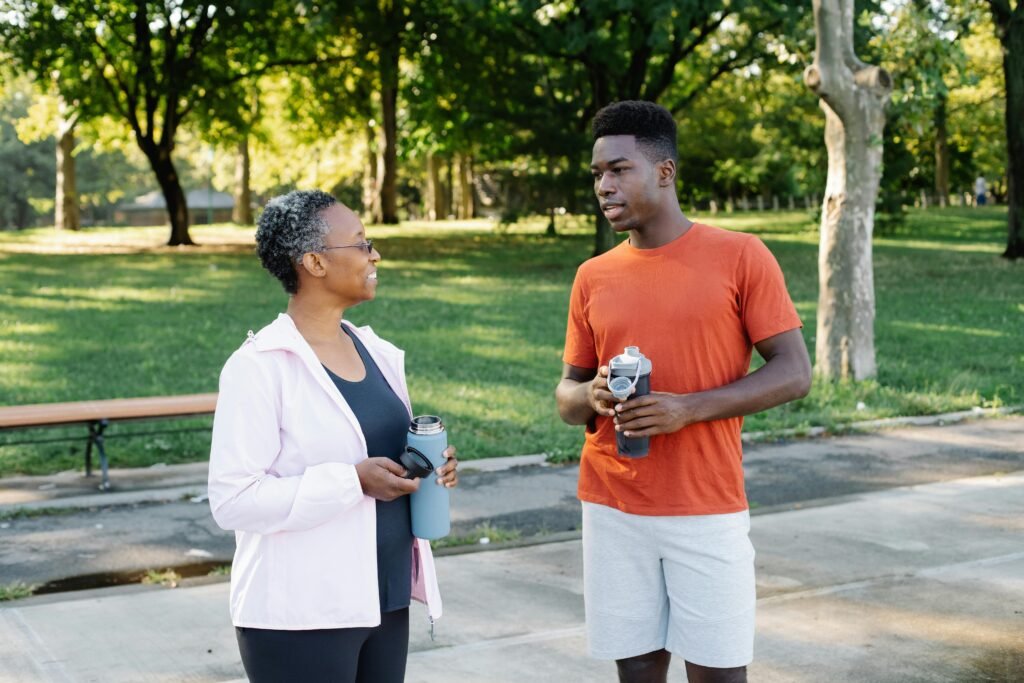Benefits of Walking for All Fitness Levels

Walking is often overlooked as a mere means of transportation, but it actually serves as an incredibly effective workout that can enhance overall fitness levels. Engaging in regular walking sessions can boost cardiovascular health, strengthen muscles, and improve mental well-being. It’s a low-impact exercise that is accessible to almost everyone and can be easily incorporated into daily routines. So, rather than viewing walking solely as a way to get from one point to another, consider it a valuable addition to your fitness regimen. It’s an easy activity that helps your health in amazing ways. Whether you’re new to exercise or very experienced, walking is good for all. Put on your shoes and start walking now!
Key Takeaways
Walking makes your heart stronger and increases energy. Try walking fast for 30 minutes most days to help your heart.
Walking often lowers the chance of problems like high blood pressure and diabetes. It helps you stay at a healthy weight and use insulin better.
Walking helps your mind by lowering stress and improving creativity. A short walk can help you relax and think of new ideas.
Physical Benefits of Walking as a Workout
Boosts cardiovascular health and stamina
Walking is an easy way to help your heart. Regular walking makes your heart stronger and builds stamina. Fast walking helps your heart pump better and use oxygen well. This makes daily tasks feel easier over time. Walking can be slow or fast, depending on your choice. Whether you walk around your block or take a quick route, your heart gets healthier.
Tip: Try walking fast for 30 minutes most days to improve your heart health.
Reduces the risk of chronic conditions
Walking can protect you from serious health problems. Studies show walking at a steady pace is as good as harder workouts. It lowers the chance of high blood pressure, cholesterol, and Type 2 diabetes. Walking also helps control blood sugar and improves how your body uses insulin. The CDC says walking is great for avoiding heart disease and other health issues.
Why walking helps:
It keeps blood moving well, easing pressure on your heart.
It helps you stay at a healthy weight, lowering health risks.
It’s an easy way to reach 150-300 minutes of weekly exercise.
Strengthens muscles and supports joint health
Walking isn’t just for your heart; it helps muscles and joints too. Each step works your leg muscles, making them stronger. Walking keeps joints flexible and reduces stiffness. If you worry about joint pain, don’t. Walking is gentle on knees and hips. Adding walking to your routine keeps you active without hurting your body.
Note: Walking on trails or hills can make muscles stronger and improve balance.
Mental Benefits of Walking
Eases stress and lifts your mood
Walking is an easy way to feel happier. When you walk, your body makes endorphins, which help reduce stress. It’s like giving your mind a short break. Walking also helps with anxiety by letting you breathe deeply and focus on your steps.
Tip: Walk in a park or near water. Nature makes walking even more calming and refreshing.
Had a rough day? Walking can be your stress-buster. It’s not just about the physical benefits; it’s about finding peace while moving.
Boosts brainpower and creativity
Did you know walking helps you think better? A Stanford study showed walking improves creative thinking by 60% compared to sitting. Whether solving problems or brainstorming, walking helps your brain work better.
Study highlights:
81% of people felt more creative while walking.
Walking indoors or outside worked the same.
While walking itself sparked new ideas.
Walking isn’t just for your body—it’s great for your mind too. Stuck on a problem? Take a walk and let your ideas flow.
Clears your mind and helps you relax
Walking helps you focus and forget distractions. The steady steps make it easier to think or enjoy quiet time.
| Study Results | What They Show |
|---|---|
| Creativity Boost | Walking improves creative thinking by 60%. |
| Participant Creativity | 81% felt more creative after walking. |
| Better Mood | Physical activity leads to feeling happier. |
Walking isn’t just exercise; it’s a way to clear your head. Whether you need calm or energy, walking helps your mind feel better.
How to Make Walking a Better Low-Impact Exercise
Change speed, incline, and time for more effort
You can make walking harder by changing speed, incline, or time. Walking fast for short times can turn a simple walk into a great cardio workout. Adding hills or slopes makes your heart beat faster and works your legs more. This makes walking tougher but also more rewarding.
| Incline Level | Muscle Use Increase | Calories Burned More |
|---|---|---|
| 0° | Normal | Normal |
| 3° | Higher | 17% |
| 6° | Even Higher | 32% |
For example, a 155-pound person walking at 3.5 mph on flat ground burns about 267 calories in an hour. Walking uphill at the same speed can burn around 422 calories. Changing these things makes walking fun and a good low-impact workout.
Tip: Start on flat ground, then slowly add hills or speed to avoid injuries and get stronger.
Use good posture to get the most out of it
Walking with good posture helps you get better results. Keep your head up, shoulders loose, and arms moving naturally. Tighten your core and take steady steps. This helps your posture and makes walking easier on your joints.
Don’t slouch or stare at your phone while walking. Good posture lowers body strain and makes walking more comfortable.
Note: Wearing good shoes helps you keep proper form and avoid injuries.
Add intervals, weights, or new paths
Make walking more fun by trying intervals, light weights, or new places. Switch between walking fast and slow to make your workout better. This keeps your heart rate up but is still easy on your joints.
Using light hand weights can work your arms while you walk. Walking on trails, in parks, or on sand adds variety and feels like an adventure.
Try This: Walk at a normal pace for 2 minutes, then fast for 1 minute. Repeat for 20 minutes for a great cardio workout.
Changing things keeps walking fun and helps you stick with it regularly.
Walking is more than just a way to move—it’s a simple yet powerful tool for improving your health. It boosts your body, clears your mind, and fits into any lifestyle. Whether you’re a beginner or a fitness enthusiast, walking adapts to your needs. So, lace up your shoes and start today. You’ll feel the difference!
https://www.health.harvard.edu/
https://blissfullway.com/7-mindfulness-practices-to-boost-productivity/
FAQ
How much walking should I do daily to see benefits?
Aim for 30 minutes of brisk walking most days. If that feels too much, start small and build up gradually.
Can walking help me lose weight?
Yes! Walking burns calories and boosts metabolism. Combine it with healthy eating for better results. Adding hills or intervals can increase calorie burn.
What should I wear for walking?
Wear comfortable clothes and supportive shoes. Choose breathable fabrics for hot weather and layer up when it’s cold.
Tip: Invest in good walking shoes to avoid discomfort or injuries.







